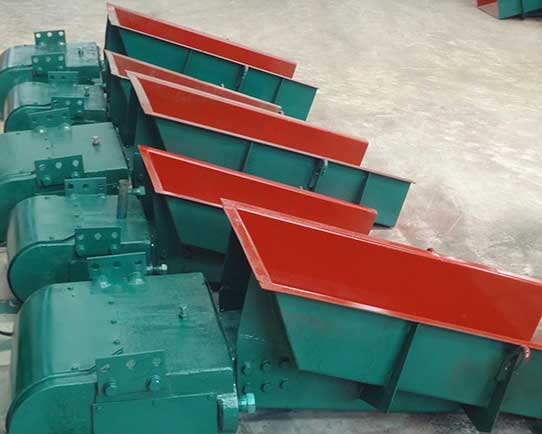Electromagnetic Vibrating Feeder
An electromagnetic vibrating feeder also called an electromagnetic vibrating feeder referred to as an electromagnetic feeder can be divided into two types: open type and closed type. The electromagnetic vibrator is used as the vibration source to drive the hopper to work, and it is used to transport the material from the storage bin or Uniform or quantitative supply from other storage equipment to the receiving equipment.
Read More: What is a vibrating feeder

Control loop
The control equipment of this series of electromagnetic vibrating feeders adopts a thyristor half-wave rectification circuit, so the feeding amount can be adjusted steplessly by adjusting the development angle of the thyristor during use, and the production process can be realized. Centralized control and automatic control.
Working principle
The electromagnetic vibrating feeder uses the magnetic force generated by the electromagnetic coil and the electromagnetic armature to transmit the high-frequency vibration force to the trough through the trough and the supporting spring plate so that the material can be quickly dispersed and moved forward at a uniform speed. The feeder is equipped with an advanced electronic control system that can adjust the speed by adjusting the potentiometer knob to ensure that the feeder achieves the purpose of quantitative feeding according to user requirements.
Structure
It is mainly composed of a trough, electromagnetic exciter, and shock absorber. The exciter is composed of an electromagnet (iron core and coil), an armature, and the main vibration spring installed between the two. It is the excitation source that generates vibration. The work of the exciter can be controlled by a certain control device.
5 Advantages of Electromagnetic Vibrating Feeder
- The amplitude is 1.5-3mm small, the vibration frequency is high, up to 3000 times/min, the material flow can be changed and opened and closed instantaneously, and the feeding accuracy is high.
- The material in the feeding chute is continuously thrown up during the feeding process and jumps forward according to the parabolic trajectory, so the wear of the feeding chute is small.
- Using the resonance principle of mechanical vibration, the two-mass works in a low-critical near-resonance state, so it consumes less power.
- No external frequency converter is needed to realize the step-less adjustment of the feeding amount remotely from the control box, and it can start frequently and run continuously under the conditions of rated voltage and amplitude.
- The material trough made of alloy steel plate can be used to transport materials with severe wear or corrosion.
Application of Vibrating Feeder
The electromagnetic vibrating feeder can evenly, continuously, or quantitatively feed the bulk, granular and powdery materials from the storage warehouse or hopper to the receiving device, can adjust the feeding amount steplessly, and realize the concentration of the production process control and automatic control. It is small in size, light in weight, easy to install, has no rotating parts, does not need lubrication, is easy to maintain, has a high operating frequency, and consumes less power. Widely used in mining, metallurgy, coal, light industry, electric power, machinery, food, and other industries.
Install of Vibrating Feeder
Prepare
Before the installation of the electromagnetic vibrating feeder, the fulcrum for hanging the feeder should be welded above the discharge port of the application silo. After welding, the user should prepare the turnbuckle hook for adjusting the angle of the feeder. The telescopic adjustment is convenient for users to adjust the feeder at any time; the electromagnetic feeder is equipped with a suspension spring, which can be installed according to the corresponding position.
Electric
The outlet of the electromagnetic vibrating feeder should be connected to the outlet terminal of the electric control box of the feeder, and the 220V power supply should be connected to the inlet terminal of the electric control box; before wiring, check whether the switch of the power box is closed and whether the potentiometer knob is reset to zero.
Test
Before the test run of the electromagnetic vibrating feeder, you should operate it according to the prompt label on the vibrating head at the rear of the machine. Before powering on, you need to loosen the four fastening bolts on the upper and lower sides of the vibrating head and tighten the spare nuts to prevent the bolts from falling off and dust from entering the vibrating head during use. Internally, it affects the feeding performance of the feeder. The function of the upper and lower top wires is designed to prevent the internal spring plate from shifting due to bumps during transportation, so it must be loosened during use, otherwise, the vibration will be small and the material will not leak